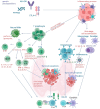The Role of the Immune System in the Course of Hashimoto's Thyroiditis: The Current State of Knowledge
- PMID: 38999993
- PMCID: PMC11241408
- DOI: 10.3390/ijms25136883
The Role of the Immune System in the Course of Hashimoto's Thyroiditis: The Current State of Knowledge
Abstract
The process of thyroid autoimmunization develops against the background of genetic predispositions associated with class II human leukocyte antigens (HLA-DR), as well as cytotoxic T-lymphocyte-associated protein 4 (CTLA-4), protein tyrosine phosphatase non-receptor type 22 (PTPN22), and forkhead transcription box protein P3 (FOXP3). Environmental factors, such as vitamin D deficiency, Zn, Se, and Mg, as well as infections, chronic stress, pregnancy, smoking, alcohol, medications, intestinal dysbiosis, and malnutrition, also play an important role. The first stage of autoimmunization involves the accumulation of macrophages and dendritic cells, as well as plasma cells. In the second stage, the mutual interactions of individual cells in the immune system lead to a decrease in the level of CD8+ in favor of CD4+, which intensifies the synthesis of T lymphocyte derivatives, especially Th1, Th17, Tfh, and Tc, reducing the level of Treg. Consequently, the number of the anti-inflammatory cytokines IL10 and IL2 decreases, and the synthesis of the pro-inflammatory cytokines IL-2, Il-12, Il-17, IL-21, IL-22, IFN-γ, and TNF-α increases. The latter two especially trigger the pyroptosis process involving the inflammasome. Activation of the inflammasome by IL-β and IL-18 produced by macrophages is one of the mechanisms of pyroptosis in the course of Hashimoto's thyroiditis, involving Gram-negative bacteria and NLRC4. In the next step, the apoptosis of thyroid cells is initiated by the intensification of perforin, granzyme, and proteoglycan synthesis by Tc and NK cells. The current findings raise many possibilities regarding interventions related to the inhibition of pro-inflammatory cytokines and the stimulation of anti-inflammatory cytokines produced by both T and B lymphocytes. Furthermore, since there is currently no effective method for treating thyroid autoimmunity, a summary of the review may provide answers regarding the treatment of not only Hashimoto's thyroiditis, but also other autoimmune diseases associated with autoimmunity.
Keywords: B lymphocytes; Hashimoto’s disease; T helper cells; T lymphocytes; apoptosis; natural killer; pyroptosis; regulatory T cells.
Conflict of interest statement
The authors declare no conflicts of interest.
Figures





References
-
- Kristensen B. Regulatory B and T cell responses in patients with autoimmune thyroid disease and healthy controls. Dan. Med. J. 2016;63:B5177. - PubMed
Publication types
MeSH terms
Substances
LinkOut - more resources
Full Text Sources
Research Materials
Miscellaneous

